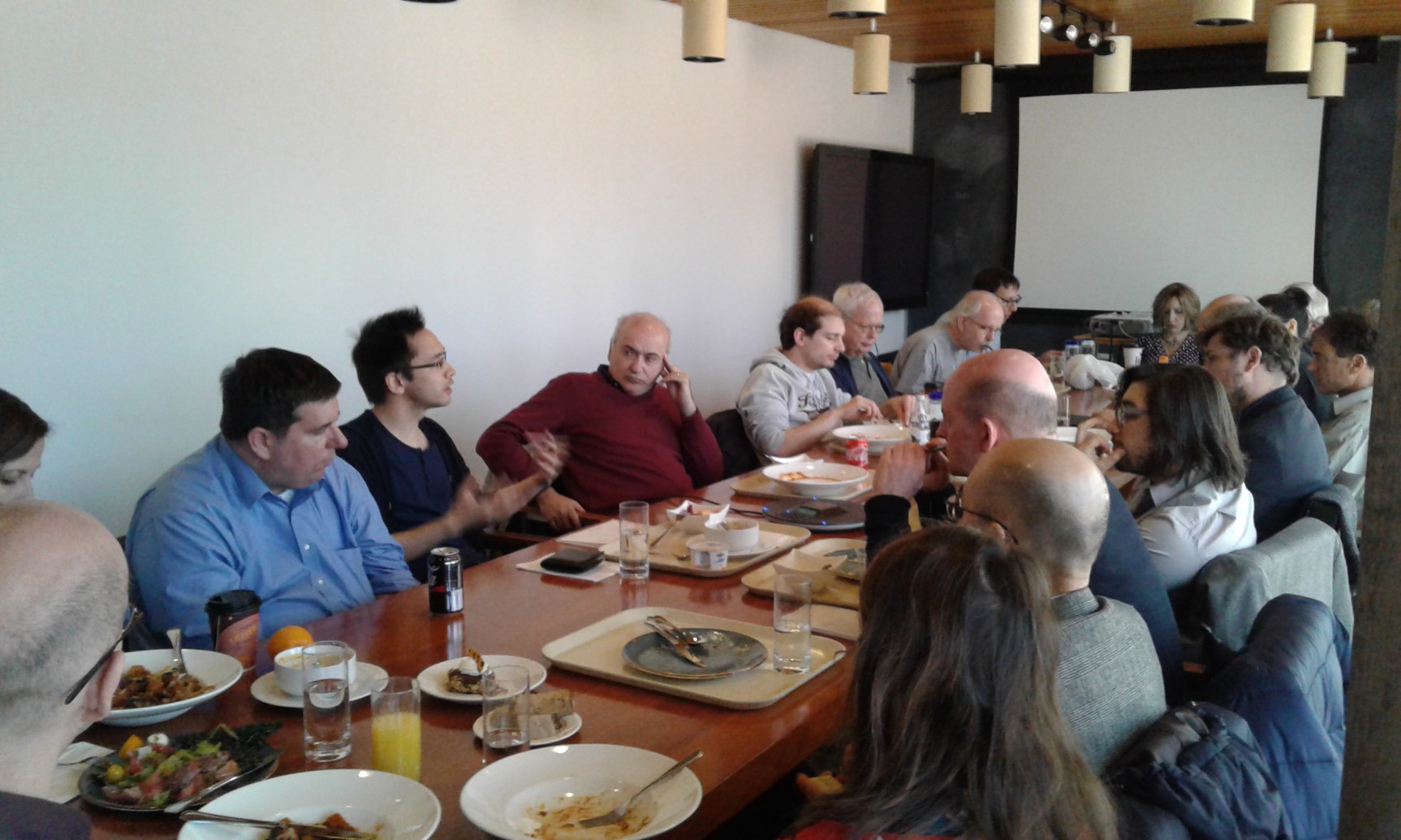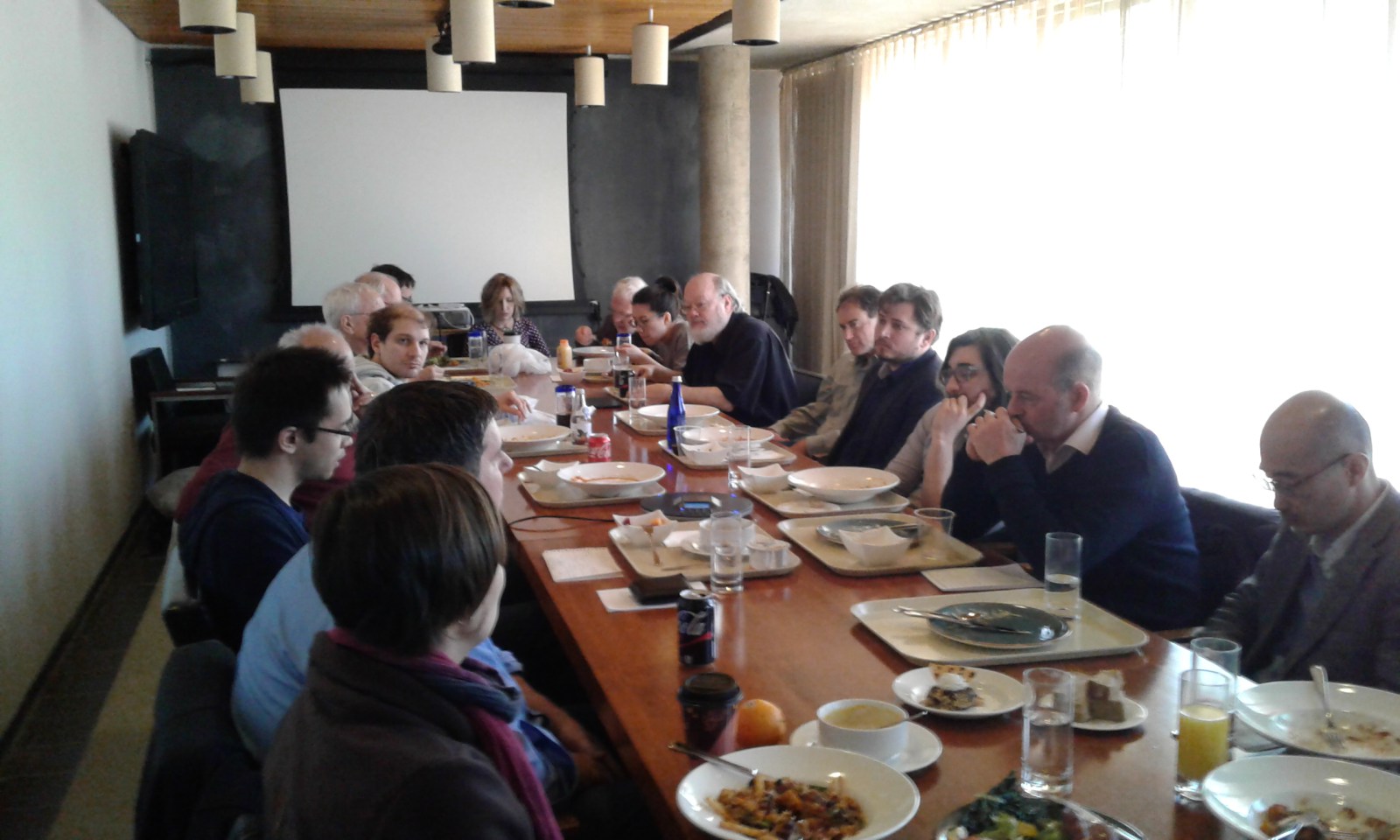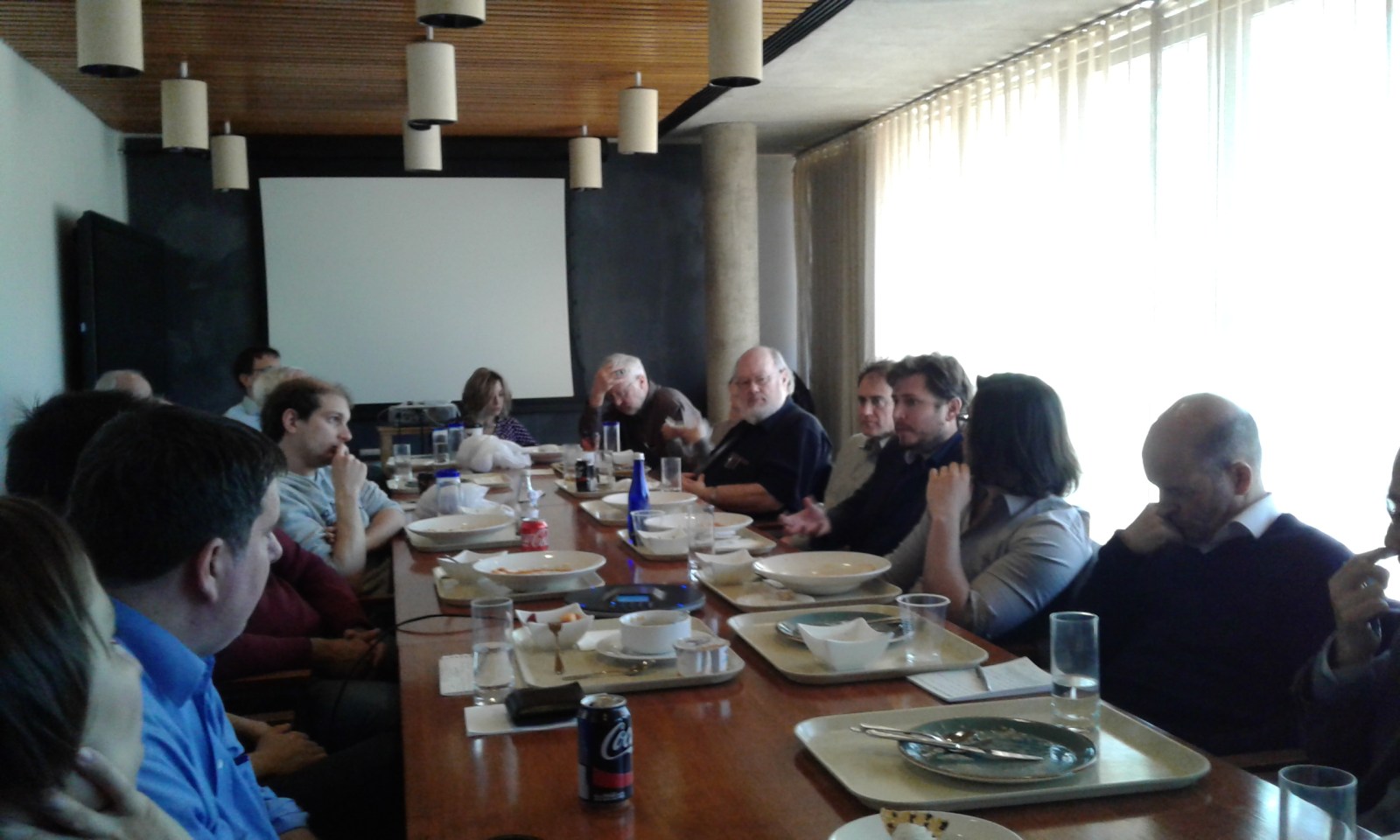3/29/17 David Fergusson YHouse Lunch IAS Synopsis
On Thursdays at noon Yhouse holds a lunch meeting at the Institute of Advanced Study, in Princeton. The format is a 15 minute informal talk by a speaker followed by a longer open-ended discussion among the participants, triggered by, but not necessarily confined to, the topic of the talk. In order to share I am posting a synopsis of the weekly meetings.
Speaker: David Fergusson (New College in the University of Edinburgh)
Title: Psychotherapy and the self in wartime Edinburgh
Abstract: (By the Speaker) “My project explores developments in psychotherapy with shell-shocked soldiers at Craiglockhart War Hospital (1916-19) in Edinburgh. Through Pat Barker’s 1991 novel (and the film) Regeneration, the story of Siegfried Sassoon and his encounters with Rivers, his psychiatrist, and Owen, a younger war poet, is well known. But the work of other key practitioners and the wider significance of their experimental therapeutic methods deserves further attention during the centenary commemorations.”
Present: David Fergusson, Paul Mundey, Sean Sakamoto, Susan Schneider, Piet Hut, Ayako Fuqui, Andreas Losch, Nicolaas Rupke, Bob MacLennan, Naoki Yajima, Monica Manolescu, Michael Solomon
David has been involved in an interdisciplinary project in Edinburgh involving psychotherapists, historians, physicians, theologians, and others. The project takes a holistic approach to looking at the whole person in the history of psychotherapy, at the influence of World War I in this development, and specifically at WW I Shell Shock treatment in Edinburgh. The project has been influenced by the work of John Macmurray, a prominent Scottish philosopher and theologian whose own thinking was influenced by his participation in WW I, and who has been compared with Martin Buber. The activity at Craiglockhart War Hospital in Edinburgh between 1916 and 1919 is the focus of this talk. The term Shell Shock was introduced by military psychiatrist C.S. Myers in The Lancet in 1915 to describe combat stress disorders. Later psychiatrists eschewed the term since the causes and symptoms of combat stress were so varied, but the term is still used in popular discourse. Symptoms include both external manifestations such as blindness, deafness loss of speech, twitching, tremor, stuttering, etc., and internal manifestations such as memory loss, insomnia, nightmares, etc. The senior officers serving at Craiglockhart War Hospital included three psychiatrists, Dr. Arthur Brock, Dr. William H.R. Rivers, and Dr Arthur Ruggles. Two of the patients treated there for shell shock were
Wilfred Owen and Sigfried Sassoon, both of whom became noted poets. The 1991 novel “Regeneration” by Pat Barker, subsequently made into a movie, explores the relation between Sassoon and his psychiatrist Rivers. Dr.Brock practiced Ergo Therapy, which involved keeping patients busy and occupied and reintegrating them into the community. Rivers was influenced by Freud. Instead of drugs or hypnosis, he developed a form of the ‘talking cure’ which helped the patient to deal with painful and suppressed memories. Sassoon was older than Owen and the two came from different social backgrounds. Sassoon’s family was wealthy while Owen was from a lower financial and social class. Sassoon encouraged the younger man to write as part of his therapy. Owen became the editor of the Hydra, a hospital journal named both for the fact that the hospital building had formerly been a spa (hydro) hotel, and after the many-headed monster that Hercules defeated as one of his tasks. Owen was returned to the fighting in France after leaving the hospital and died one week before the armistice. Sassoon had grown disillusioned by the war and became a conscientious objector. Having already been decorated for bravery, he was hospitalized rather than imprisoned. Sassoon also returned to the lines but survived the war. Sassoon’s poem “Dreamers” in the Hydra writes:
I see them in foul dug-outs, gnawed by rats,
And in the ruined trenches, lashed with rain,
Dreaming of things they did with balls and bats,
And mocked by hopeless longing to regain
Bank-holidays, and picture shows, and spats,
And going to the office in the train.
Owen’s poem Anthem For Doomed Youth was also composed at Craiglockhart.
What passing-bells for these who die as cattle?
Only the monstrous anger of the guns.
Only the stuttering rifles’ rapid rattle
Can patter out their hasty orisons.
No mockeries now for them; no prayers nor bells,
Nor any voice of mourning save the choirs, –
The shrill, demented choirs of wailing shells;
And bugles calling for them from sad shires.
David described the outcomes at the hospital. 1736 patients were treated. 44% returned to the front lines. The rest were declared unfit for service at the front though many were able to fill non-combatant positions. Tavestock Clinic and Butler Hospital (in Rhode Island) were founded and run by Dr. Hugh Crighton Miller and Dr. Arthur Ruggles respectively. Both had learned lessons from treating shell-shocked patients – Ruggles in EdinburghThe hospital today is now the main campus of Edinburgh Napier University.
This historical project raises several issues for further investigation by the project teamUnder intolerable conditions, strong, healthy and courageous young men experienced severe psychological stress resulting in this disorder. The stigma still exists. Many such patients are considered or consider themselves weak. The treatment requires time and resources that are not always made available. Some in David’s group view this early psychotherapeutic work as offering alternative and more holistic approaches to counteract the over-medicalisation of sadness and grief.
Discussion began with:
Q: Monica pointed out the distinction between the terms Post Traumatic Stress Disorder, which we use today, and Shell Shock. Those with PTSD are recognized as the victim and these patients are not returned to combat.
A: One manifestation of what was shell shock would be considered PTSD now. But shell shock included other disorders also. We lack statistics on relapse of those sent back to combat. There are references to combat stress disorders in ancient literature. The American Civil War was the first Industrial war with conscription and more massive destruction, and there was a much higher incidence of shell shock than was described previously for hardened professional soldiers in past wars.
Q: Susan had a grad student now teaching at West Point whose thesis was on PTSD. She said Propranalol is effective if given before or even a few hours after the trauma and helps them to forget. She mentioned the movie “The Eternal Sunshine of the Spotless Mind”. She reported the military is working on implantable chips to block the PTSD response. Her student was concerned that these treatments with medications causing amnesia did not honor the memory of those who had died in combat.
Michael said that propranolol is not an amnesic medication but is a beta adrenergic blocker. That is, it slows the heart rate and prevents the physiologic response. His understanding of PTSD is that any memory of the traumatic event results in an overwhelming repetition of the physiologic fight or flight reaction appropriate and necessary to survive the stress at the time, but maladaptive when one cannot forget or ignore the horror of the event later. The palpitations, diaphoresis, dry mouth and wide open pupils, inability to concentrate or to suppress the memories are body responses to the psychological stimuli, and these are what propranolol blocks.
Susan believed that there was also a loss of memory and this had become a concern for example in rape victims providing testimony in court.
Q: Nicolaas asked how did the Germans or the French treat shell shock in view of the tremendous nationalism inherent in their societies at the time?
A: David answered similar treatments were offered. He noted Freud’s influence. He reported the Americans were better prepared for this when they entered the war due to the experience of the Europeans.
Q: Piet asked what about the 1870 war between Germany and France?
A: The treatment was similar then as well as in the Boer War and in the 1903 Russo-Japanese war. The problem was also seen after high speed Railroad accidents, when for the first time in history devastation and trauma on that scale was seen. The disorder was called Weak Heart Condition or Spinal Condition based on then current thinking, but was not referred to as trauma. The disorder was also linked to Hysteria and men thought they were behaving like women and had lost their manhood.
Q: Nicolaas returned to social acceptability and noted that there was so much nationalism that the social reaction to soldiers showing their “weakness” may have been problematic.
A: There was fear that shell shock was contagious, and this contributed to the perceived need to return patients to combat. The military saw patients without physical wounds as shirkers. Dr. Rivers, who did not agree, left under a cloud before the end of the war because the administrators thought the doctors were pandering to weakness.
Q: Bob asked Why would we want to send these people back to combat? He referred to a talk he had attended about the Vietnam War that questioned the use of conscription.
A: David reported that all of society was invested in this course. During the war they enlisted soldiers from mental hospitals, so it is no wonder that many couldn’t cope. The soldiers felt they were fighting for their families, their religion, and their way of life.
Q: Piet asked if the main issue was conscription or industrialization of the fighting?
A: Conscription was introduced in England in 1917. It had been used previously in the American Civil War. David referred to the Press Gangs: sailors would get men drunk or would knock them out and then drag them to the boats and sail off in order to maintain the navy.
Bob noted that in ancient Rome families were encouraged to have babies to provide soldiers.
Q: Sean shared that he had served as a Medic. His mission was to “preserve the fighting forces”, not to help people. In the military context caring about the soldiers was not significant. He noted that in the Napoleonic wars 70% of the casualties were from disease and not from combat. Sanitation in the camps preserved more lives than any other intervention. Sean also noted that talk treatments were not very effective. When talk therapy was tried after the genocide in Rwanda, many did not want to talk but only to forget and go outside.
Piet wondered if the belief in spirits influenced these people and led them to avoid dark rooms.
Paul agreed that his father, a WW II veteran who had landed at Normandy, never talked about it.
Nicolaas stated that the cultural location of these things is important. In the Netherlands after WW II people would talk about the German concentration camps, but never about the Japanese.
Piet agreed and recalled seeing men in the Netherlands who had been 15 to 18 years old during the German occupation and had been sent to occupy Indonesia where they had committed atrocities. These men sat alone in bars and would never talk about their experiences. Some Vietnam veterans had similar reactions.
Sean suggested that PTSD may occur when people cross their moral boundaries.
Paul referred to Drew Faust’s book “This Republic of Suffering: Death and the American Civil War”.
Piet suggested that the development of Photography in the Civil War contributed to the change from romanticizing warfare to showing honestly the horrors.
David emphasized the importance of talk therapy and the importance of professional relationships in healing. “It’s the love of the physician that heals the patient.” (Sandor Ferenczi) Treatment probably became much less effective when the patients were returned to the line to fight.
Bob referred to Chekov’s short story “Ward Six” in which a young doctor is changed by a friendship with a patient. He wondered whether the psychiatrists had transforming experiences.
Paul referred to McNamara’s memoirs of his own role in the Vietnam war and his need to lament that role.
David reported that around 300 British soldiers were court martialed and shot for refusing orders. Many were likely suffering from shell shock. Under the circumstances, it seems astonishing that mutiny was not more widespread.
Piet recalled the story of soldiers from opposing sides playing a soccer game during a break in the fighting on Christmas on the front lines in WW I.
David recounted that at the battle of Princeton when the fighting stopped the two sides helped each other to care for the dead and wounded remaining on the battle field.
Paul lives near Gettysburg and recalled stories of combatants needing to re-engage later in life.
Michael tried to relate our discussion to the perspective of Consciousness. He believes that the interaction of the physical and the mental is what PTSD is about. Re-experiencing the physiologic responses of panic to the intolerably traumatic mental circumstances that initially triggered that response is what he sees as PTSD.
At this time, we ended our discussion. David’s talk was surprisingly not primarily theological, but was a valuable addition to our series of lunch meetings.
Respectfully,
Michael Solomon, MD


![[#12] Nudging the Home of the Little Prince: Protecting the Earth from Impacts](https://images.squarespace-cdn.com/content/v1/585711b3ebbd1a051da20b4d/1506723060643-F2SFT16LTY30OQPTXTPW/B612-blog-image.jpg)
![[#11] Pioneering Years in AI in Astrophysics](https://images.squarespace-cdn.com/content/v1/585711b3ebbd1a051da20b4d/1505726496846-FHHSXJAE74XH6VUTLJ0S/096C2226-B411-46F3-BE9310D7AFDFC71D_agenda.jpg)
![[#10] The Nature of Reality: Matter, Experience, Appearance, Presence](https://images.squarespace-cdn.com/content/v1/585711b3ebbd1a051da20b4d/1505594381735-6DMKIXSU6TZ2W6SM3RGP/domestic-cat-726989_1920+%281%29.jpg)

![[#9] Mind and Magnetic Monopoles: Matter, Mind and Magic](https://images.squarespace-cdn.com/content/v1/585711b3ebbd1a051da20b4d/1504527474143-IHFOHQLMY3NJYOLTOB6P/magnetic-monopole-seach.jpg)
![[#8] Universal Biology: the Next Frontier in Science](https://images.squarespace-cdn.com/content/v1/585711b3ebbd1a051da20b4d/1504293495720-JGVQ9OUJVFX1JWV06W91/eon.jpg)
![[#7] Is Science Really Empirical?](https://images.squarespace-cdn.com/content/v1/585711b3ebbd1a051da20b4d/1503811967755-DX3PU2U0G82SATE0DIQR/rikkyo.jpg)

![[#6] Open Source Revolutions, in the 17th and 20th Centuries](https://images.squarespace-cdn.com/content/v1/585711b3ebbd1a051da20b4d/1502839963709-FA9ER0PNVUZLB6GQR3QL/121212_2_OpenSwissKnife.png)
![[#5] The Secret of Life: Reliable Systems from Unreliable Parts](https://images.squarespace-cdn.com/content/v1/585711b3ebbd1a051da20b4d/1502091658287-JJO6MPQA0K1AK6GVTESD/Lynx_kitten.jpg)
![[#4] Suspension of Judgment: The Cornerstone of Science](https://images.squarespace-cdn.com/content/v1/585711b3ebbd1a051da20b4d/1501816681087-X6L0FEID0LQZFY1QJVUQ/Graphics-3d-Animation-Design-Court-Justice-882726.jpg)
![[#3] The Mind-World Circle: Two Aspects of Reality](https://images.squarespace-cdn.com/content/v1/585711b3ebbd1a051da20b4d/1501215287463-NNSU7IE2H0H8UE9F4M1I/Shigakogen_Yudanaka-Yaenkoen_2010_0824_Young_Monkey_Picks_up_rock_to_examine.JPG)
![[#2] The Mass-Force Circle: Mysteries vs. Puzzles](https://images.squarespace-cdn.com/content/v1/585711b3ebbd1a051da20b4d/1500108609905-NBXCCUG84RJ8AEFUQO7I/Work-Material-Creativity-Equipment-Spring-Artistic-1740654.jpg)
![[#1] On Matter and Information: The Origin of Recipes](https://images.squarespace-cdn.com/content/v1/585711b3ebbd1a051da20b4d/1496673263361-AC41FK0WC23NO92U50EI/matter-info.jpg)
![[#0] The "Y" in YHouse](https://images.squarespace-cdn.com/content/v1/585711b3ebbd1a051da20b4d/1496673153667-G1HKRKOE8J9M6WSR5V5B/yhouse-logo.jpg)







